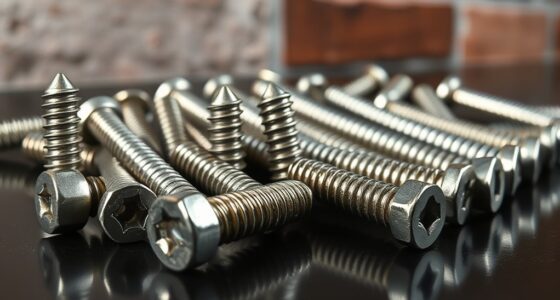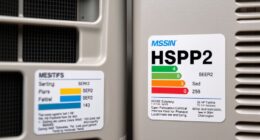If you’re looking for the top carbon monoxide detectors for 2025, I recommend options that combine advanced electrochemical sensors with reliable power sources like battery backups or plug-in models with easy-to-read displays. Features such as loud alarms, visual indicators, and certification from UL or ETL guarantee safety and reliability. These detectors are suitable for various homes, offering quick alerts and peace of mind. Keep exploring the options ahead to find the best fit for your safety needs.
Key Takeaways
- Look for detectors with UL, ETL, or CSA certification to ensure safety and reliability standards are met.
- Choose models with electrochemical sensors for quick, accurate CO detection and long sensor lifespan.
- Opt for plug-in or hardwired units with battery backup for continuous protection during power outages.
- Prioritize detectors with loud alarms (≥85dB) and clear digital displays for easy monitoring and quick response.
- Consider multi-function detectors that monitor additional environmental factors like natural gas, temperature, and humidity.
Amazon Smart Air Quality Monitor – Know your air, Works with Alexa
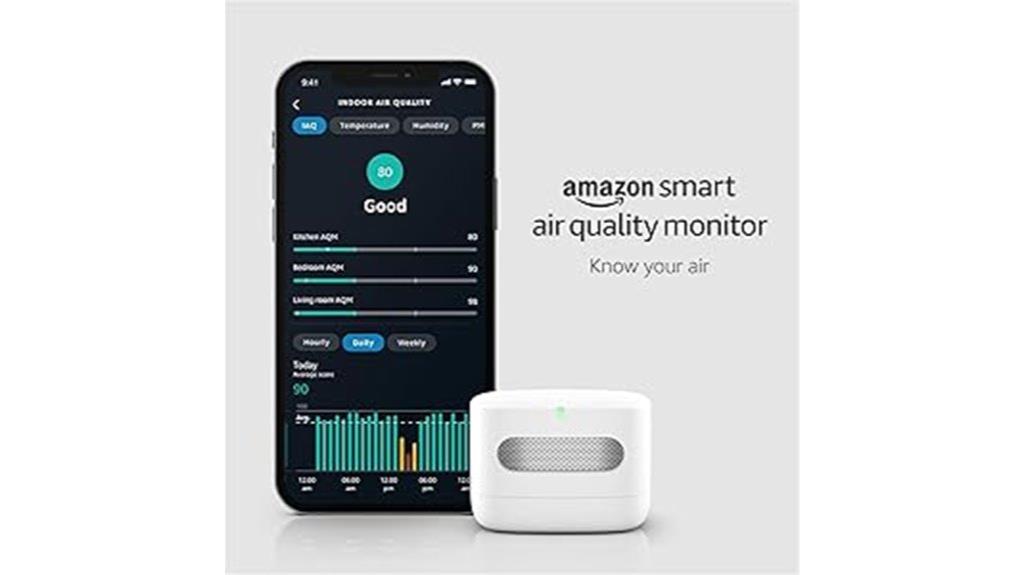
If you’re looking for an easy-to-use air quality monitor that integrates seamlessly with your smart home, the Amazon Smart Air Quality Monitor is an excellent choice. It measures five key parameters—PM 2.5, VOCs, CO, humidity, and temperature—and displays clear, color-coded indicators via the Alexa app. Setup is quick, taking less than ten minutes, and it connects easily through Wi-Fi and Bluetooth. I appreciate its automatic calibration and real-time alerts, which help me stay aware of indoor air quality. Plus, it can trigger routines to activate fans or purifiers automatically when pollution levels rise, making it a practical, budget-friendly addition to any smart home.
Best For: homeowners and smart home enthusiasts seeking an easy, affordable way to monitor indoor air quality and automate air management routines seamlessly with Alexa.
Pros:
- Simple, quick setup with minimal technical knowledge required
- Real-time air quality insights and automatic calibration ensure ongoing accuracy
- Integration with Alexa routines allows automated control of fans, purifiers, and alerts
Cons:
- UI for setting thresholds can be imprecise and lacks detailed visibility of current levels
- Limited to Alexa ecosystem; notifications depend on Alexa app-based alerts
- Displays temperature only in Celsius, which may be inconvenient for some users
4-in-1 Natural Gas and Carbon Monoxide Leak Detector
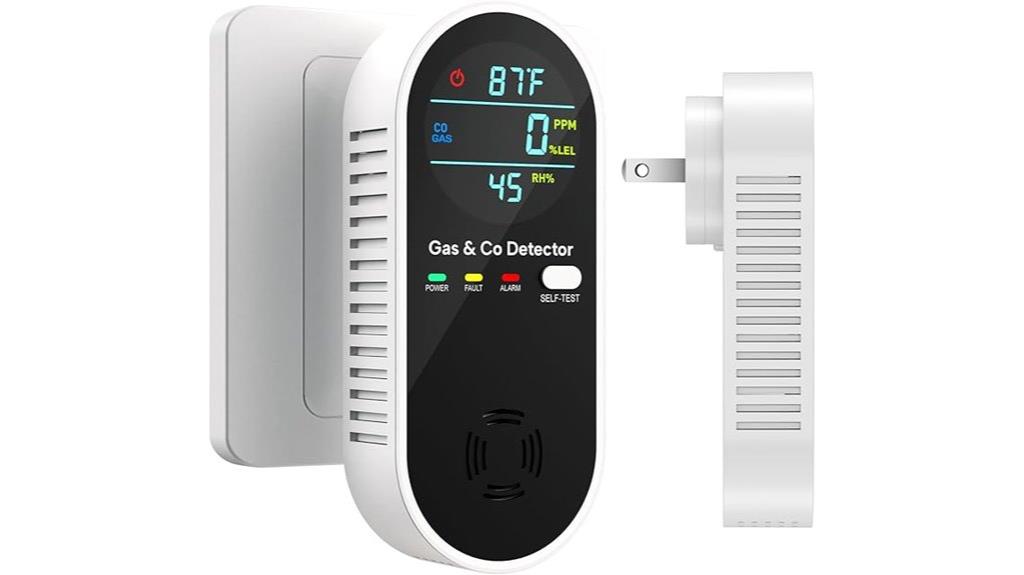
Looking for a reliable device that combines multiple safety sensors into one compact unit? The 4-in-1 Natural Gas and Carbon Monoxide Leak Detector fits the bill perfectly. It detects natural gas, CO, temperature, and humidity with dual sensors and alarms, providing real-time readings on a clear LCD screen. When gas levels reach dangerous thresholds, it triggers loud alarms and flashing lights to alert you instantly. Its plug-in design is energy-efficient and easy to set up, ideal for homes, RVs, or hotels. With long-lasting sensors and simple operation, this all-in-one detector offers exhaustive safety without taking up much space.
Best For: homeowners, RV travelers, and hotel managers seeking an all-in-one safety device for gas leak detection and environmental monitoring.
Pros:
- Combines sensors for natural gas, CO, temperature, and humidity in a compact, space-saving design
- Features dual alarms with loud sound and flashing lights for immediate warning of hazards
- Energy-efficient plug-in operation with durable, long-lasting sensors
Cons:
- Requires about 180 seconds for calibration after plugging in before accurate readings are available
- Needs 30 minutes of operation to provide precise temperature and humidity data
- May need periodic maintenance or sensor calibration to ensure ongoing accuracy
Kidde Battery-Powered Carbon Monoxide Detector
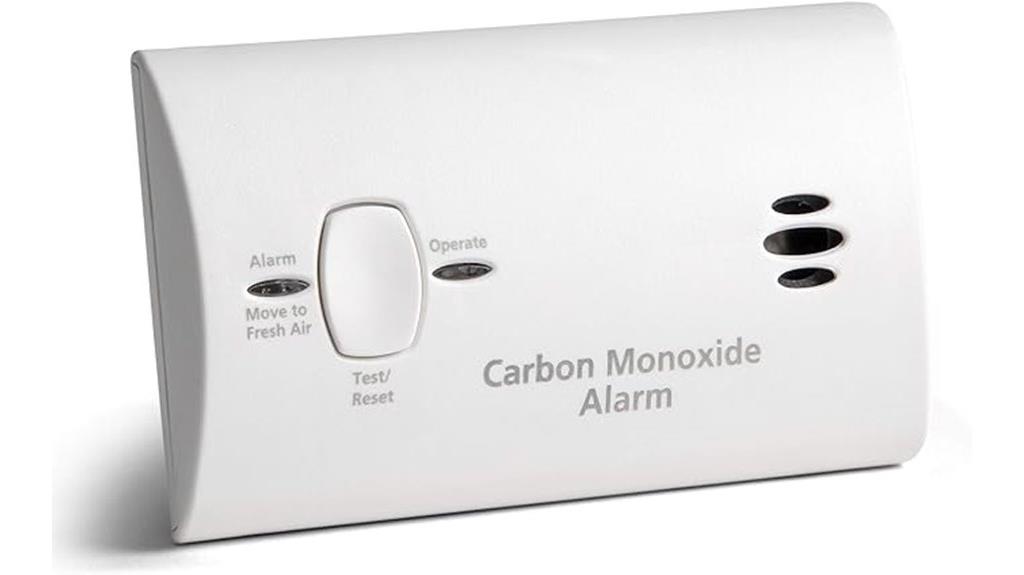
The Kidde Battery-Powered Carbon Monoxide Detector stands out as an ideal choice for those seeking reliable, portable CO protection without the need for wiring. Powered by two AA batteries, it’s easy to install on walls or tabletops, ensuring safety even during power outages. Its electrochemical sensor provides accurate detection, triggering an 85-decibel alarm and flashing red LED when CO is present. The device includes useful features like a test-reset button, low battery indicator, and event memory. Compact and lightweight, it’s perfect for all areas of the home, offering peace of mind with simple, wiring-free operation and a lifespan of up to 10 years.
Best For: households seeking a reliable, portable, and easy-to-install carbon monoxide detector that functions during power outages and requires no wiring.
Pros:
- Wire-free installation allows flexible placement on walls or tabletops.
- Long-lasting with a 10-year lifespan and easy battery replacement.
- Features like event memory, test-reset button, and low battery indicator enhance usability.
Cons:
- Battery dependency means regular replacement is necessary for continuous protection.
- Limited to battery power, which may be less suitable for those preferring hardwired systems.
- Compact size might make it less noticeable in some locations.
First Alert CO400 Carbon Monoxide Detector (1-Pack)
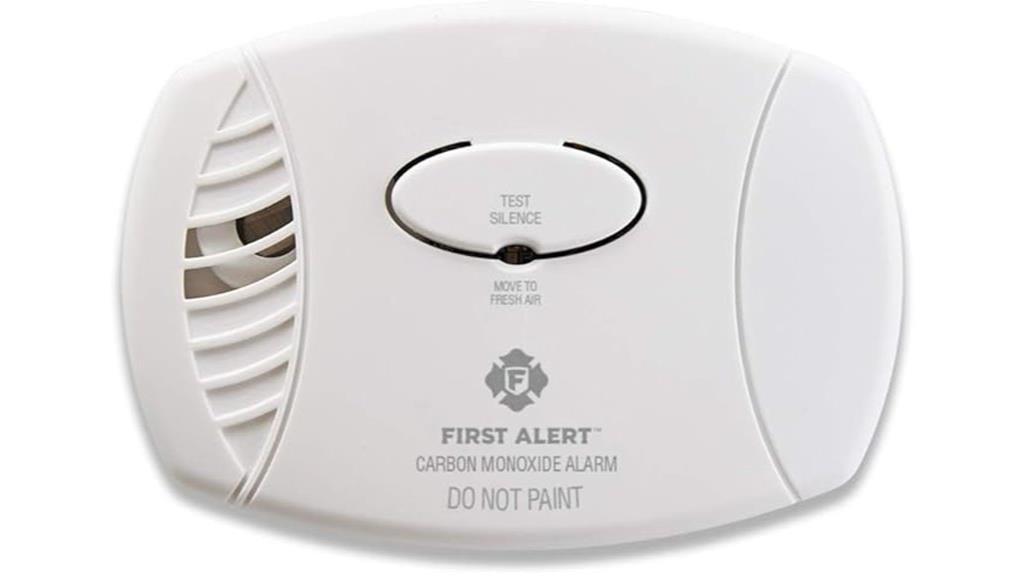
The First Alert CO400 Carbon Monoxide Detector (1-Pack) is an excellent choice for homeowners seeking reliable, battery-powered CO detection without the hassle of wiring. It features an advanced electrochemical sensor with a lifespan of up to five years, ensuring accurate and long-term protection. Powered by a replaceable 9V battery, it stays operational during power outages. The device emits an 85-decibel alarm and includes visual alerts for low battery and end-of-life signals. Its sleek design allows flexible placement, either on a wall or surface, making it easy to install and maintain. Overall, the CO400 offers dependable, maintenance-friendly safety for any home.
Best For: homeowners seeking a reliable, easy-to-install, battery-operated carbon monoxide detector for comprehensive home safety.
Pros:
- Long-lasting electrochemical sensor with up to 5 years of effective operation
- Battery-powered, ensuring continuous protection during power outages
- Easy to install with no wiring required and clear visual and audible alerts
Cons:
- Battery compartment may be difficult to open for some users
- Placement options might be limited by home decor or furniture considerations
- Requires replacement of batteries after several years, which may be overlooked without regular testing
First Alert Carbon Monoxide Detector with Battery Backup
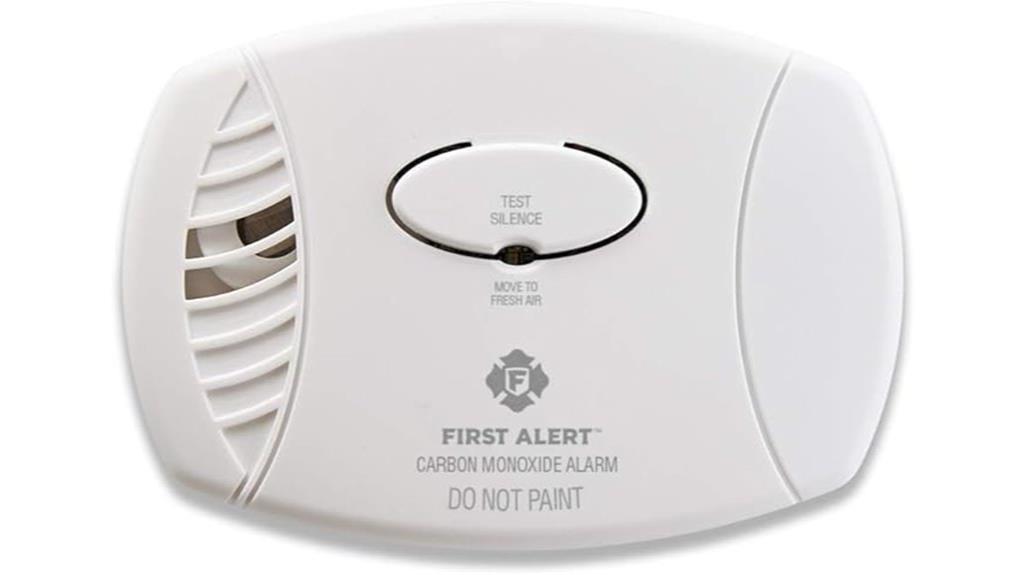
If you want a reliable CO detector that’s easy to install and guarantees continuous protection, the First Alert CO605 with battery backup is an excellent choice. It’s a plug-in device that requires no mounting, making setup quick and straightforward. Equipped with an advanced electrochemical sensor, it detects carbon monoxide accurately and promptly. The 85-decibel alarm is loud enough to wake you during emergencies, and a soft red indicator confirms operation. The unit includes a 9V battery backup, ensuring it works during power outages. With a lifespan of 7 years and UL certification, it offers dependable safety, making it a smart addition to any home.
Best For: homeowners seeking an easy-to-install, reliable CO detector with continuous protection during power outages.
Pros:
- Easy to install plug-in design without the need for mounting
- Accurate detection with advanced electrochemical sensor technology
- 7-year lifespan with UL certification and battery backup for safety during outages
Cons:
- Fragile battery compartment lever may be difficult to close securely
- Initial chirping if batteries are not installed correctly
- Some users find the soft indicator light less noticeable in bright environments
Carbon Monoxide Detectors with LCD Display and Sound Alarm
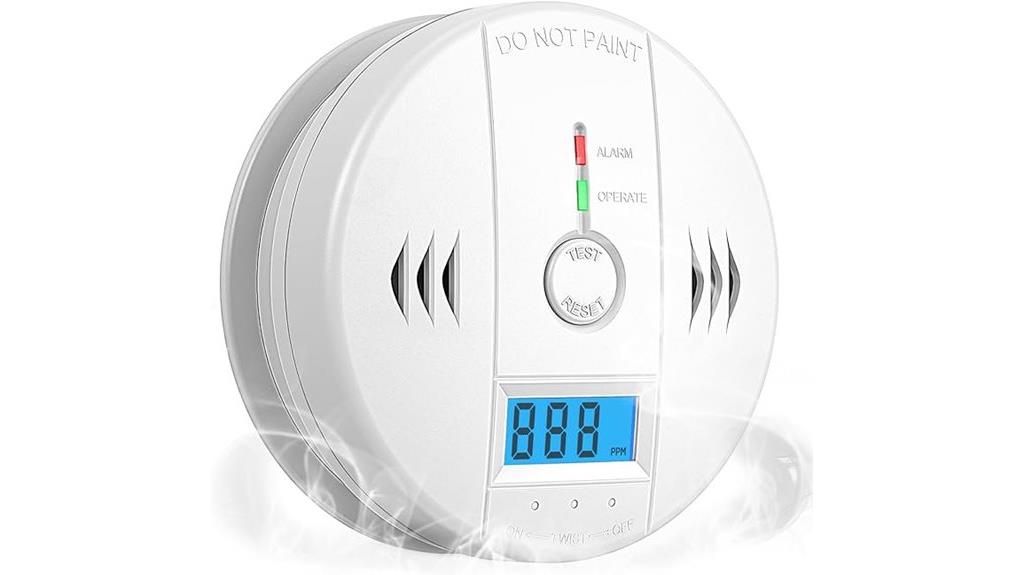
For anyone seeking reliable and easy-to-read CO detection, carbon monoxide detectors with LCD displays and sound alarms stand out as an excellent choice. These devices use high-accuracy electrochemical sensors to detect CO levels quickly and reliably, with alarm thresholds set at 50ppm, 100ppm, and 300ppm. The 85dB alarm alerts you effectively within a 20-40m² range. The LCD screen continuously shows real-time CO levels, providing peace of mind. Powered by batteries, they’re easy to install and unaffected by power outages. Certified by UL standards, they include features like end-of-life indicators and self-tests, ensuring consistent, dependable safety monitoring.
Best For: households, small offices, and commercial spaces seeking reliable, easy-to-read carbon monoxide detection with real-time monitoring and alarms.
Pros:
- High-accuracy electrochemical sensor ensures quick and reliable detection of CO levels.
- Continuous LCD display provides real-time readings for peace of mind.
- Simple installation with battery power and no wiring needed, plus UL certification for safety.
Cons:
- Some units may have minor assembly issues, such as loose wires during battery installation.
- Lack of smart home integration or remote monitoring features.
- Batteries are user-replaceable but may be missing upon arrival or require periodic checks.
Carbon Monoxide and Gas Detectors (4-in-1)
https://m.media-amazon.com/images/I/61+JaX44jCL._AC_SX679_.jpg
Those seeking a reliable, all-in-one safety device will appreciate the Nsrrye 4-in-1 Carbon Monoxide and Gas Detector, which combines CO and combustible gas detection with environmental monitoring. This plug-in device features a bright digital display that shows CO levels, gas concentrations, temperature, and humidity in real-time. Equipped with professional-grade sensors, it quickly detects natural gas, propane, methane, and more, triggering an 85dB alarm and visual warning when hazards are present. Compact and easy to install, it offers continuous 24/7 monitoring, helping you identify leaks or ventilation issues. Its user-friendly design and multi-functionality make it a valuable addition to any home or travel setting.
Best For: homeowners and travelers seeking a reliable, all-in-one device for detecting carbon monoxide, combustible gases, and monitoring environmental conditions in indoor or enclosed spaces.
Pros:
- Combines CO and combustible gas detection with temperature and humidity monitoring in one compact unit
- Bright digital display offers real-time, easy-to-read environmental data
- Loud 85dB alarm and visual warnings provide immediate alerts for safety hazards
Cons:
- Relies solely on AC power, so it does not operate during power outages without a backup battery
- Some users report false alarms or discrepancies in temperature and humidity readings
- Does not include batteries, requiring additional measures for backup during outages
Kidde Carbon Monoxide Detector with Battery Backup
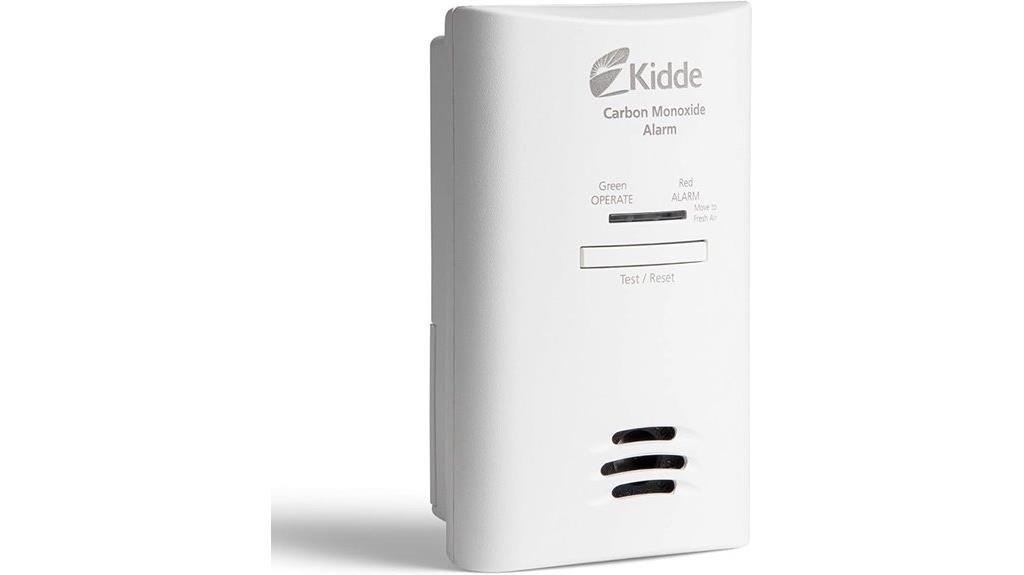
The Kidde Carbon Monoxide Detector with Battery Backup stands out as an excellent choice for homeowners seeking reliable protection during power outages. It’s easy to install—just plug it into a standard 120V outlet—and the 2-AA batteries guarantee continuous operation if the power goes out. The 85-decibel alarm quickly alerts me to dangerous CO levels, while the Test-Hush button makes testing and silencing false alarms simple. I appreciate the peak level memory feature, which records the last detection or test. Its wall plug-in design offers straightforward setup, and the battery backup provides peace of mind, knowing I’m protected even during outages.
4-in-1 Carbon Monoxide and Gas Leak Detector with Temperature and Humidity Sensors
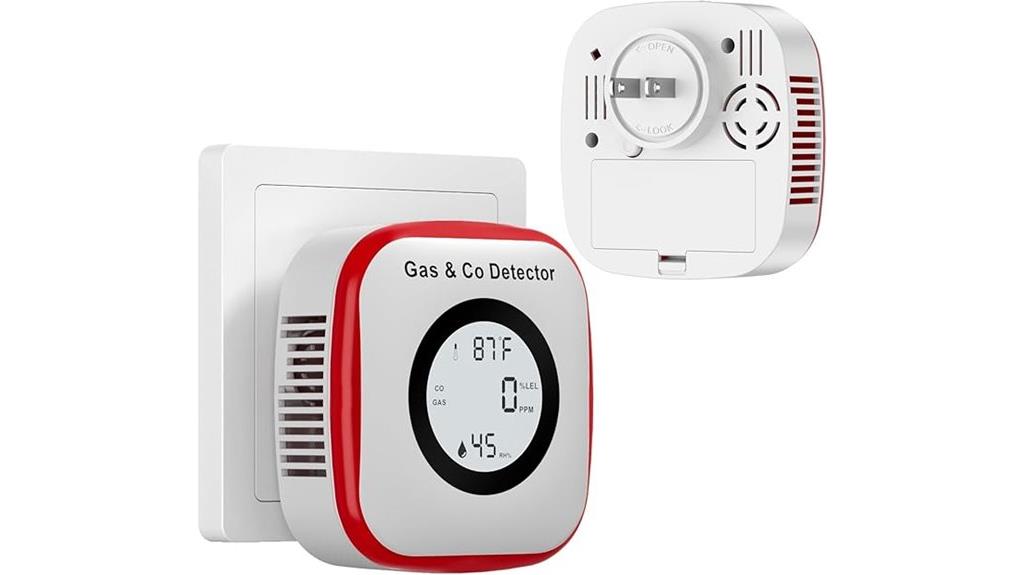
If you’re seeking a versatile detector that combines multiple safety features, the in-1 Carbon Monoxide and Gas Leak Detector with Temperature and Humidity Sensors stands out. It’s a 4-in-1 device that monitors carbon monoxide, natural gas, and combustible gases like methane and propane. It also displays ambient temperature and humidity, helping you spot environmental issues early. Designed for portability, it can be plugged into standard sockets or used on a desktop, making it suitable for homes, RVs, or hotels. With a loud alarm (≥85 dB) and red light, it ensures you’re alerted immediately to dangerous levels. Plus, it has battery backup for continuous safety even during power outages.
Best For: Homeowners, renters, and travelers seeking a comprehensive safety device to detect gas leaks, monitor environmental conditions, and ensure safety during power outages.
Pros:
- Combines multiple safety features (CO, natural gas, combustible gases, temperature, and humidity) in one compact device.
- Portable and versatile, suitable for various environments like homes, RVs, hotels, and more.
- Equipped with a loud alarm and red light for immediate alerts, plus battery backup for continuous operation during outages.
Cons:
- No batteries are included, requiring users to provide their own backup power source.
- Needs a preheating period of 180 seconds and calibration time of 30 minutes for accurate readings.
- Installation requires ensuring proper operation, including removing protective film and proper placement, which may be overlooked by some users.
3 Pack Carbon Monoxide Detectors with LCD Display
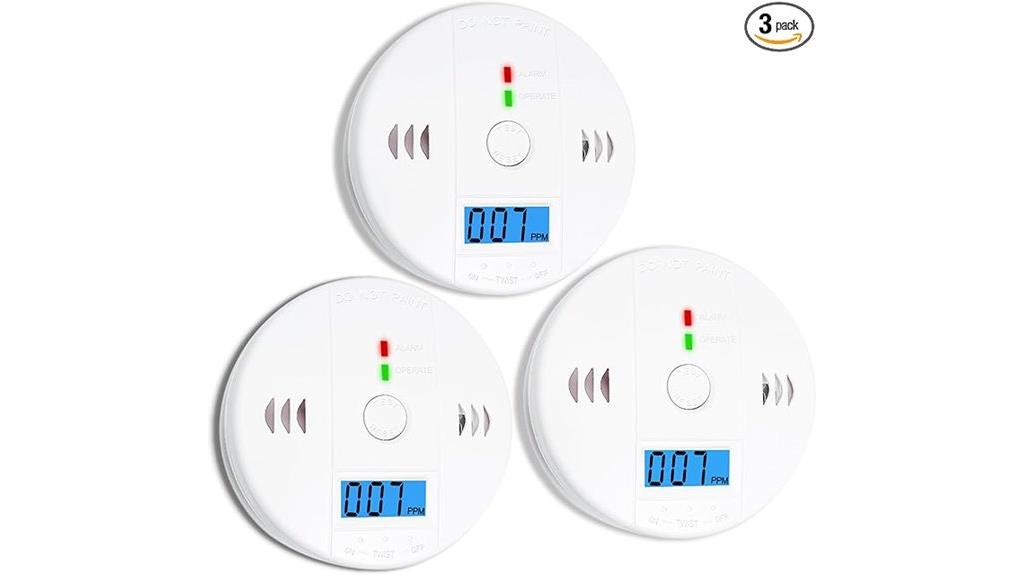
A 3-pack of carbon monoxide detectors with LCD displays offers an excellent solution for homeowners and travelers who want reliable, real-time CO monitoring across multiple indoor spaces. These detectors are compact, lightweight, and easy to install without hardwiring, making them versatile for walls, ceilings, or portable use. Powered by three AA batteries with a 36-month lifespan, they provide long-lasting protection. The LCD clearly shows current CO levels, battery status, and malfunctions, while the alarm triggers loudly at dangerous levels. Their advanced sensors ensure accurate detection, giving me peace of mind whether at home or on the go.
Best For: homeowners, travelers, and indoor space managers seeking reliable, easy-to-install carbon monoxide detection across multiple environments.
Pros:
- Easy to install without hardwiring, suitable for walls, ceilings, or portable use
- Long battery life of approximately 36 months with clear LCD display of CO levels and battery status
- Compact, lightweight design with reliable electrochemical sensors for accurate detection
Cons:
- Small screws may require larger or different screws for secure mounting
- Mounting instructions lack clarity, which could complicate installation
- Basic design may lack additional features found in more advanced detectors
Digital Carbon Monoxide Detector with LCD Display and Sound Warning (3 Pack)
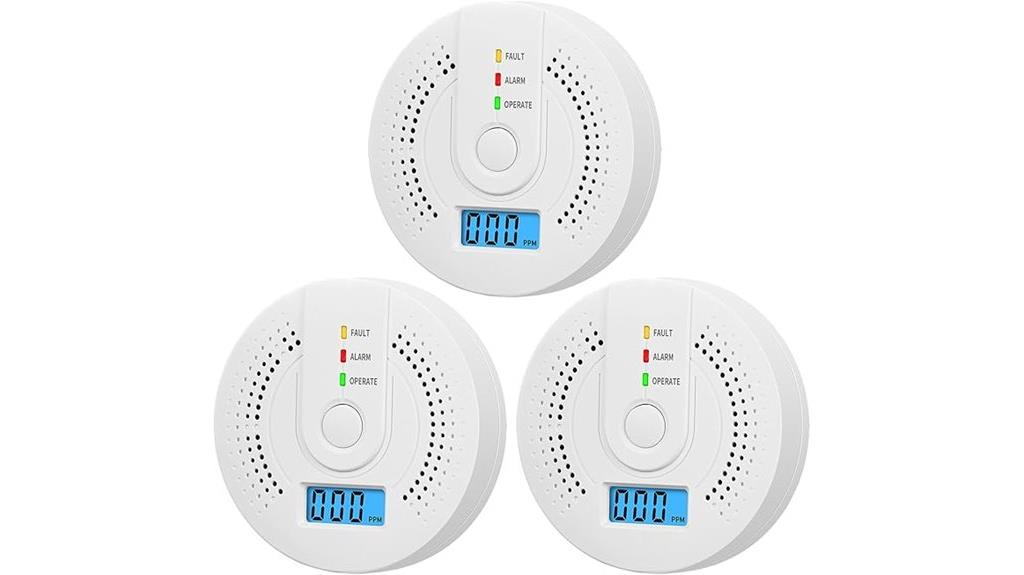
For anyone seeking reliable, easy-to-install carbon monoxide detection, the Digital Carbon Monoxide Detector with LCD Display and Sound Warning (3 Pack) stands out. It’s simple to set up with included screws, no hardwiring needed, and runs on 2 AA batteries, ensuring continuous protection even during outages. Its compact, lightweight design fits well in any room, and the LCD shows real-time CO levels for added peace of mind. When dangerous CO is detected, a loud 85-decibel alarm sounds, and red LEDs flash. With features like self-testing, low battery indicators, and a trusted electrochemical sensor, this pack provides dependable safety for your home or workplace.
Best For: homeowners, renters, and property managers seeking a reliable, easy-to-install CO detector for comprehensive indoor safety.
Pros:
- Easy installation with included screws, no hardwiring required.
- Continuous monitoring powered by batteries, functioning during power outages.
- Clear LCD display shows real-time CO levels and alerts for low battery or malfunction.
Cons:
- Batteries (not included) need regular replacement for optimal performance.
- Some users report false alarms or constant flashing lights.
- Limited to indoor use; not suitable for outdoor environments.
4-in-1 Gas Leak and Carbon Monoxide Detector
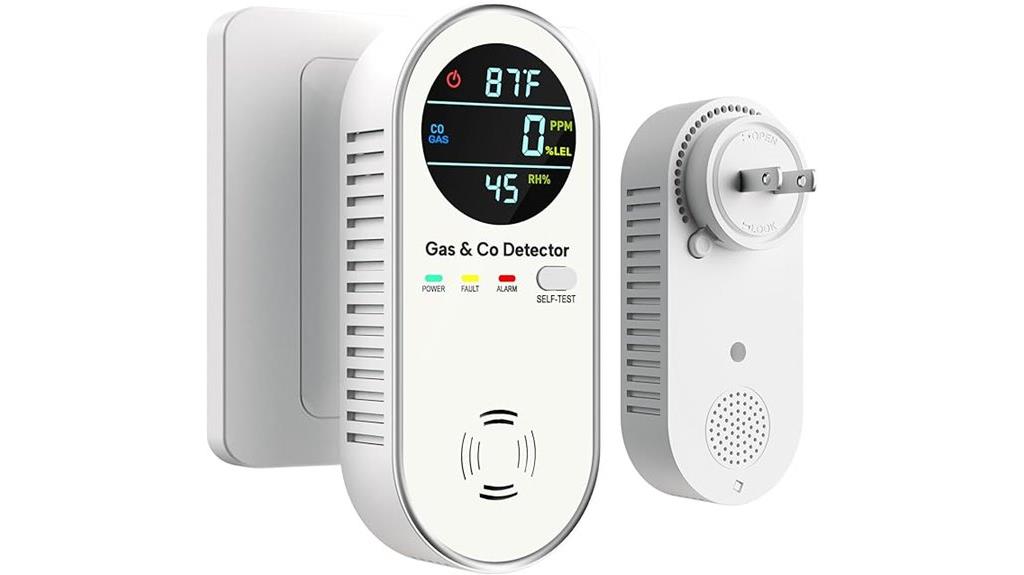
The in-1 Gas Leak and Carbon Monoxide Detector stands out for its all-encompassing sensing capabilities, making it an ideal choice for homeowners who want all-in-one protection. It combines sensors for natural gas, propane, CO, temperature, and humidity, providing thorough safety coverage. The device features a clear LCD display with real-time readings, dual alarms, and quick response alerts. Its compact, plug-in design fits easily into standard outlets and uses minimal power. With loud alarms and visual indicators, it ensures you’re immediately notified of dangers, whether at home, in an RV, or on a ship. I trust this detector to keep my household safe from multiple threats.
Best For: homeowners, RV owners, hotel managers, and ship operators seeking comprehensive safety against gas leaks, carbon monoxide, and environmental hazards.
Pros:
- Combines multiple sensors for natural gas, propane, CO, temperature, and humidity, providing all-in-one protection.
- Rapid response with loud alarms (≥ 85 dB) and visual indicators ensure immediate alerts.
- Easy plug-in installation with a clear LCD display and low power consumption for energy efficiency.
Cons:
- Requires 180 seconds post-insertion for environmental adjustment, which may delay initial readings.
- May generate heat after powering on, potentially affecting sensitive environments or certain surfaces.
- Limited to AC 110V~220V outlets, which may restrict placement options in some regions or setups.
2 Pack Carbon Monoxide Detectors with Digital Display
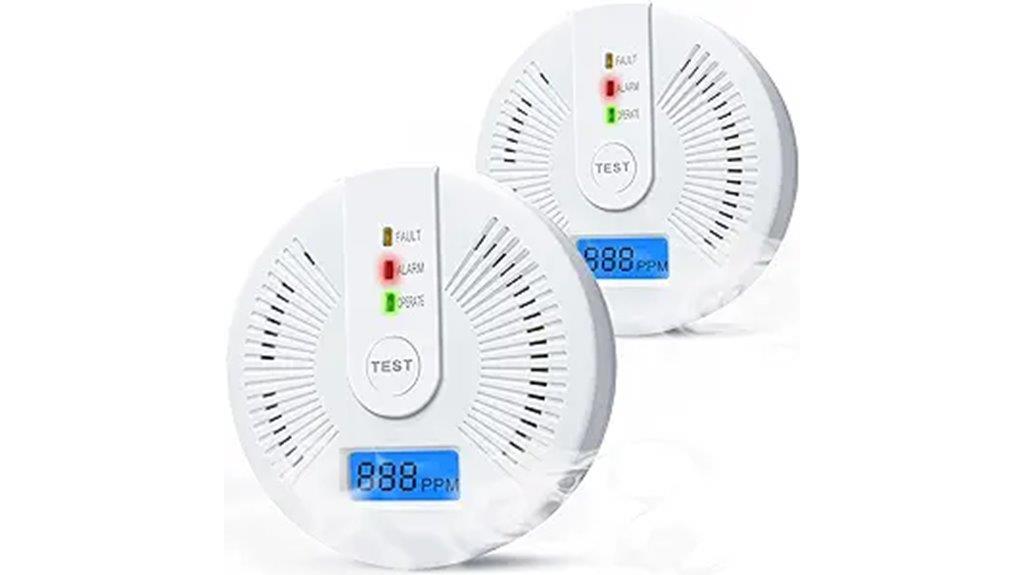
Opting for a pack of carbon monoxide detectors with digital displays makes sense if you want reliable, easy-to-read safety alerts for multiple areas. These packs typically include two battery-powered units suitable for home, bedroom, kitchen, or even outdoor use. They feature advanced sensors that quickly detect odorless, deadly CO, with clear digital readouts showing concentration levels. The simple one-button operation makes setup quick—just insert batteries and mount. An audible alarm and flashing light alert you to danger, while the bright green LED indicates normal operation. Customers appreciate their compact size, affordability, and ease of installation, making them a smart choice for extensive safety coverage.
Best For: households, apartments, or small commercial spaces seeking reliable, easy-to-read carbon monoxide detection with multiple units for comprehensive safety coverage.
Pros:
- Easy to install with no wiring required, just insert batteries and mount
- Clear digital display shows real-time CO levels for quick assessment
- Compact, affordable, and suitable for multiple environments including home, bedroom, kitchen, and outdoor areas
Cons:
- Bright green LED may be distracting or disruptive in dark or sleeping areas
- Batteries are not included, requiring purchasing separately
- The audible alarm at 85 decibels might be loud for some users or in quiet environments
Factors to Consider When Choosing Carbon Monoxide Detectors
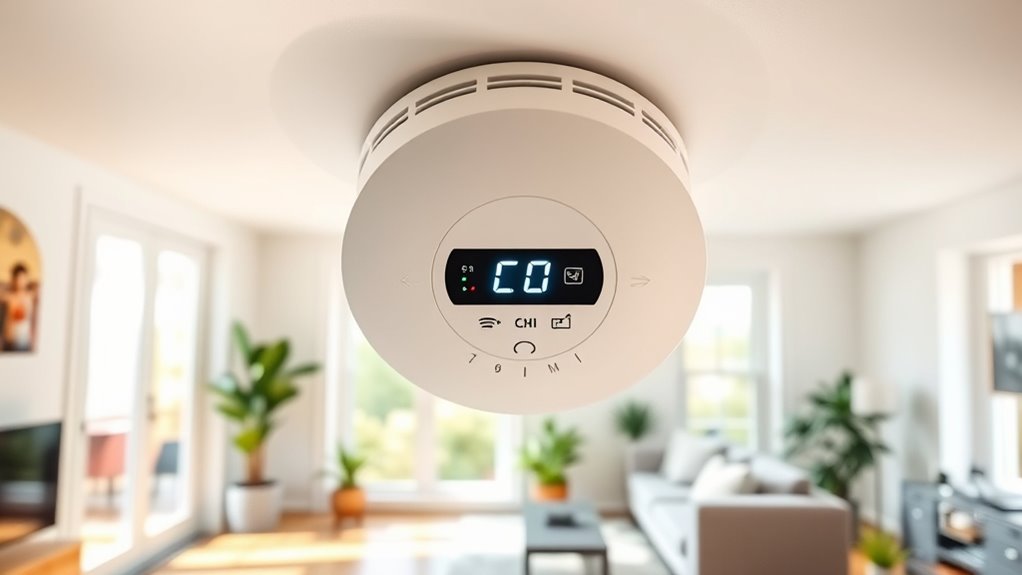
When choosing a carbon monoxide detector, I look at key factors like sensor accuracy, power options, and how loud and clear the alarm is. I also consider whether the detector has useful displays or indicators and how easy it is to install. These points help guarantee I select a reliable and user-friendly device for safety.
Sensor Accuracy and Type
Choosing the right carbon monoxide detector depends heavily on its sensor type and accuracy because these factors determine how reliably it detects dangerous CO levels. Electrochemical sensors are the most dependable, offering high precision and quick response times, making them ideal for home safety. NDIR sensors are also excellent, known for their long-term stability and accuracy in measuring CO. Sensor accuracy is usually expressed as a deviation percentage; top-quality sensors maintain ±1.0 ppm accuracy, ensuring precise detection. The sensor type also affects lifespan—electrochemical sensors typically last 5 to 10 years before needing replacement. Regular calibration or self-test features are essential, especially in devices without user-adjustable calibration, to maintain consistent accuracy over time.
Power Source Options
The power source of your carbon monoxide detector plays a key role in ensuring it’s always ready to alert you to danger. Battery-powered detectors are portable and can operate during power outages, but they require regular battery changes to stay effective. Plug-in models with battery backups are convenient, offering easy installation and reliable operation even if the power goes out. Hardwired detectors connect directly to your home’s electrical system, providing a permanent, maintenance-free solution, often with backup batteries for added security. When choosing a power source, consider your home’s electrical setup, how much maintenance you’re willing to do, and the level of backup safety you desire. Each option balances convenience, reliability, and safety differently, so select the one that best fits your needs.
Alarm Loudness and Type
A key factor in selecting a carbon monoxide detector is its alarm loudness and sound type, which directly impact your safety. Typically, alarms range from 85 to 110 decibels, loud enough to wake you from sleep or alert everyone in noisy environments. Most units emit an 85dB siren, ensuring coverage across a room. The sound can be a continuous siren, intermittent beeps, or a combination, helping you recognize the urgency quickly. It’s essential that the volume can be heard throughout your home, especially in bedrooms, where a minimum of 85dB is recommended. Some detectors also feature different tones or alerts to signal varying levels of danger, aiding in immediate understanding of the situation. An effective alarm sound is indispensable to prompt response and safe evacuation.
Display and Indicators
Since quick and clear information is essential during a CO emergency, I pay close attention to a detector’s display and indicators. A good digital display shows real-time CO levels in parts per million (PPM), giving me precise, immediate data. Visual indicators like flashing LEDs or color-coded lights quickly tell me whether the device is working properly or if there’s a danger. Some detectors have multiple indicators—alarms, status lights, and digital readouts—so I can understand different conditions at once. High-contrast screens with large numbers make reading easier, especially in low-light situations. Accurate and consistent indicators are crucial because they help me interpret CO levels and device status instantly, ensuring I can respond promptly and keep my home safe.
Installation Ease
When choosing a carbon monoxide detector, ease of installation can make a big difference in how quickly I can get it up and running. I look for models with straightforward setup, like plug-in designs or simple wall mounts, to save time. Clear, step-by-step instructions are essential, so I don’t get confused during installation. Devices with features like self-calibration or auto-configuration help reduce manual adjustments, making setup even easier. I also check that the size and mounting options fit my space, ensuring easy access and maintenance later on. User-friendly features like quick-connect brackets or magnetic mounts are a huge plus—they make attaching the detector quick and hassle-free. Overall, an easy install means I can prioritize safety without any frustration.
Maintenance Requirements
Regular maintenance is crucial to guarantee my carbon monoxide detector stays reliable. I test the alarm and functionality monthly using the built-in test button to catch any issues early. For battery-powered units, I replace the batteries every 6 to 12 months to keep them operational. Many detectors now have end-of-life indicators that alert me when it’s time to replace the entire device, usually after 5 to 7 years. Some models feature self-calibration or auto-cleaning, which reduces ongoing maintenance by maintaining sensor accuracy. I also keep the detector clean and dust-free, ensuring it’s positioned away from obstructions that could interfere with its sensitivity. Proper maintenance is essential to ensure my detector functions correctly when I need it most.
Certification and Standards
How can I be sure my carbon monoxide detector is truly reliable? The key is to check for certifications from recognized safety organizations like UL, ETL, or CSA. These labels ensure the device meets strict safety and performance standards. Look for models compliant with UL 2034 or UL 2075, which specify testing requirements for accuracy and false alarm prevention. Certifications confirm the detector has undergone rigorous testing for reliability and safety, including electrical safety and environmental resilience. Avoid uncertified products, as they might not meet regulatory standards, risking false alarms or missed detections. Choosing a certified detector gives me confidence that it’s been thoroughly tested and adheres to industry standards, helping keep my home safe and my family protected.
Frequently Asked Questions
How Often Should I Test My Carbon Monoxide Detector?
I test my carbon monoxide detector at least once a month to ensure it’s working properly. I also replace the batteries twice a year, usually during daylight saving time changes. Additionally, I follow the manufacturer’s instructions for testing and maintenance. Regular testing is vital because it guarantees the detector will alert me promptly if there’s dangerous CO in my home, keeping my family safe.
Can I Install Multiple Detectors in One Room?
Absolutely, you can install multiple detectors in one room, like a team of guardians watching over your space. I do it myself to make certain no shadow sneaks past unnoticed. Place them at different heights—one near the ceiling and another at eye level—so they catch any lurking danger from various angles. This layered approach creates a safety net, giving you peace of mind knowing your home is well-protected.
What Is the Typical Lifespan of a CO Detector?
The typical lifespan of a CO detector is around 5 to 7 years. I recommend checking the manufacturer’s instructions for specific guidance, as some detectors may last slightly longer or shorter. I make a habit of replacing mine every 5 years to guarantee they’re functioning correctly. Regular testing and battery changes help, but the detector itself has a limited lifespan, so staying vigilant is key to keeping your home safe.
Are Smart CO Detectors COmpatible With Home Automation Systems?
Smart CO detectors are like the Swiss Army knives of home safety—they often integrate seamlessly with home automation systems. I’ve found many models compatible with popular platforms like Alexa, Google Home, or Apple HomeKit, allowing me to receive alerts and control devices remotely. Just make sure to check the product specifications before buying, as compatibility varies. I love how they make monitoring safer and more convenient for busy households.
How Does Altitude Affect Carbon Monoxide Detector Performance?
Altitude can impact how well carbon monoxide detectors work because lower oxygen levels at higher elevations may cause sensors to be less accurate or slower to detect CO. I recommend choosing detectors specifically designed for high-altitude use or checking the manufacturer’s guidelines to guarantee proper performance. Regular testing and maintenance are essential, especially if you live in mountainous areas, to keep your home safe from CO risks.
Conclusion
Just like Pandora’s box, neglecting a CO detector can release unseen dangers in your home. Luckily, these 13 options are your shield, keeping you safe from silent threats. Whether you choose a smart monitor or a simple battery-powered detector, remember that prevention is key. Don’t wait for a warning like Icarus flying too close to the sun—be proactive, stay protected, and keep your home’s air as safe as a sanctuary.





